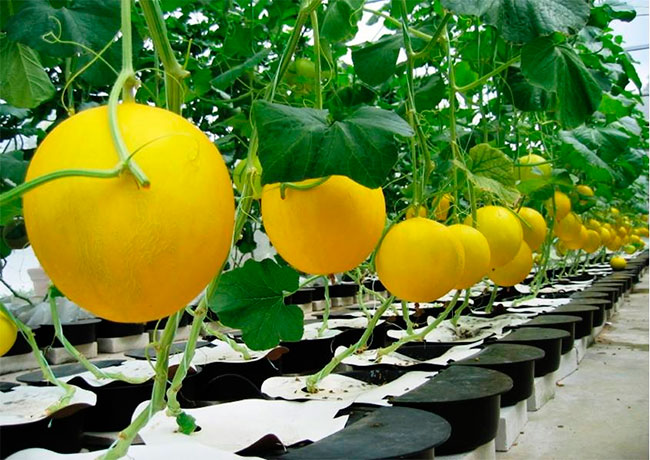Juicy, fragrant melon comes from southern countries. But what to do if the southern beauty does not grow in a harsh climate, for example in Siberia? The solution has been found, because it is possible to grow it in polycarbonate greenhouses.
Table of contents
The advantage of growing melon in a polycarbonate greenhouse
It is much easier to grow melon in the open field than in the greenhouse, since it is necessary to create and constantly maintain favorable conditions for the growth and development of the fruit:
- observe temperature
- follow the lighting
- adhere to the required humidity.
The great advantage of growing melons in the greenhouse is a year-round harvest.
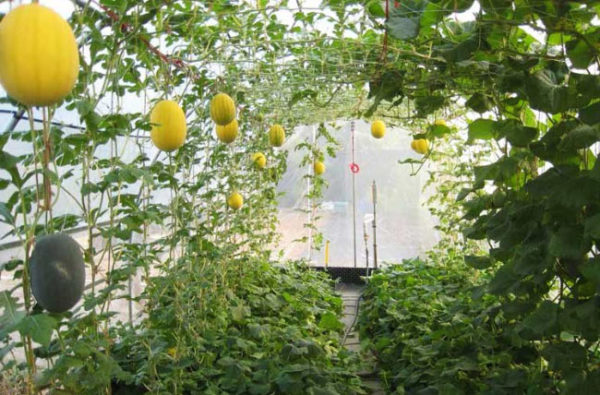
How to choose a site for landing?
Preparation of beds and soil - the key to a good harvest.
Bed formation:
- The top layer of soil is removed by 20 cm
- Further in the received trench stack branches, expanded clay and crushed stone
- Hay or grass mown on top of drainage
- Then pour humus, which is powdered with fallen leaves or sawdust
- Close all the land
- In the soil, you can add mineral fertilizers and lime (if the earth is acidic and heavy).
- The bed made is shed with warm water and covered with a dark covering material for rapid heating of the soil.
In this way, a nourishing and warm bed is obtained in which the culture will grow well and bear fruit.
How to choose a greenhouse?
In order for the melon to grow fragrant and tasty, and the bush brought a rich harvest, it is necessary to prepare a place for its growth.
Greenhouse, for this purpose is not suitable, since it has small sizes.
Greenhouse must be at least 2 meters in heightbecause the berry is a gourd crop, which grows upright along the trellis as it grows, and if you take a smaller construction, there may not be enough space for full development.
With a short-lived daylight, install specialized lamps.The plant can suffer a slight drought, but at high humidity can get fungal diseases.
Since the melon is a southern plant, for full growth and timely maturation in the greenhouse install heating devices.
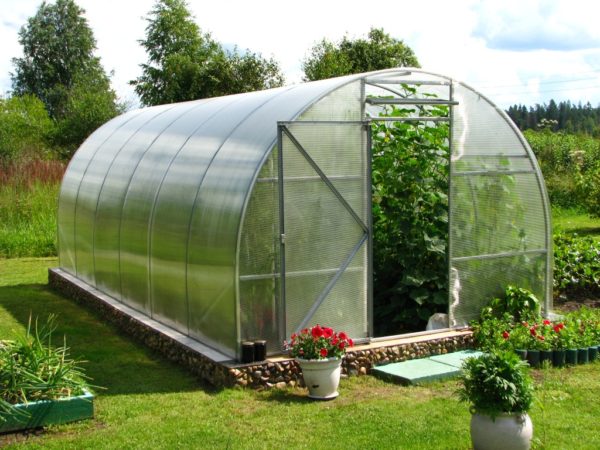
Selection and purchase of seeds
Before planting a berry, it is necessary to approach the selection of seeds with serious responsibility. What you need to pay attention to?
- Terms of ripening
- Taste qualities
- Resistance to temperature changes
- Yield level
The best varieties for growing in the greenhouse
Ideal varieties such as:
- Canaria
- Charena
- Ojen
- Collective farmer
- Galia
They have a sweet, rich taste and are ideal for growing indoors.
To grow fruits in a harsh climate, you need to acquire early ripening varieties:
- Golden
- Gribovskaya
- Tobolina
- Siberian early rim
- Zolotinka
For an earlier harvest, these varieties must be planted in a seedling manner.
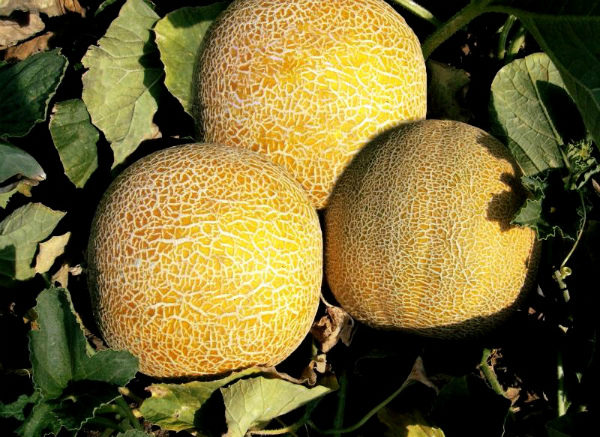
Planting and care
In the greenhouse, the berry can be grown only by the seedling method. To get a strong seedling you need to follow simple rules:
- Seeds are germinated in separate pots with a diameter of 14 cm.
- When growing seedlings, you need to withstand temperature regime: in the daytime - 20-26 degrees, at night - 18 degrees.
- Before planting, young shoots are pre-hardened, for this night temperature is reduced to 16 degrees.
- The seedling grows well on the southern windows, in cloudy weather it needs additional lighting with fitolamps.
- Watering seedlings produce warm, defended water, after drying the top layer of the earth.
- Seedlings are planted in prepared pits, which are previously shed with warm water. Liter of water per well.
- Two seedlings are planted in one hole at once, and as they grow, they are distributed in different directions.
- Seedlings are planted depending on the place of residence, approximately in the middle of May, 40 cm in a row.
Plant care is:
- In compliance with the temperature
- In providing additional light
- In warm watering
- In manual pollination
Organization of temperature and humidity conditions
In order for the plant to grow well, it is necessary to ensure the proper temperature and humidity conditions.
When growing melons in the greenhouse, the main thing is to follow the temperature schedule:
- After planting the seedlings at a constant place, the air temperature is reduced to 20 degrees, for better plant survival.
- During the formation of fruits, the temperature must also be lowered to 22 - in the afternoon and 18 - at night.
Humidity also plays an important point:
- When growing seedlings humidity should be - 21%
- During the formation of flowers and fruits - 37%
- With the growth of fruits - 32%
- At the time of ripening - 10%
Humidity should be 60-70%, when the fruit ripens, the plant requires dry air.
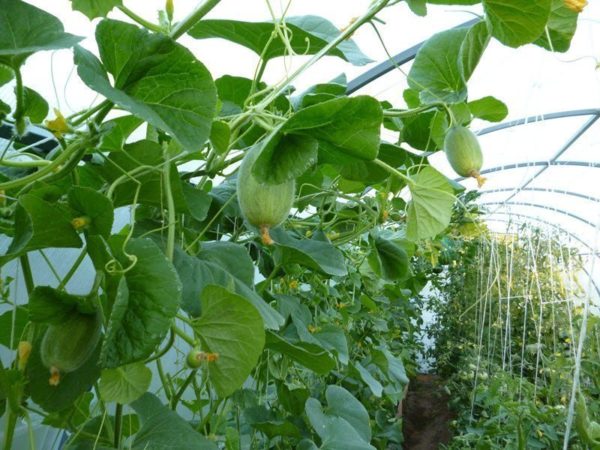
Lighting
In order for the melon to grow juicy and tasty, it is necessary to provide the plant with a 12 hour light day. With an insufficient amount of light, the plant develops poorly. To do this, install a special lamp to extend the day.
Longer lighting adversely affects the plant, flowering comes with a delay, which leads to late fruiting.
Necessary equipment for the care of fruits
With insufficient light and to maintain the desired temperature, you can install additional equipment.
As a source of artificial lighting can be applied:
- Phytolamps
- Fluorescent lamps
- LED bulbs
- Metal halide lamps
For additional heating you can apply:
- Heaters
- Convectors
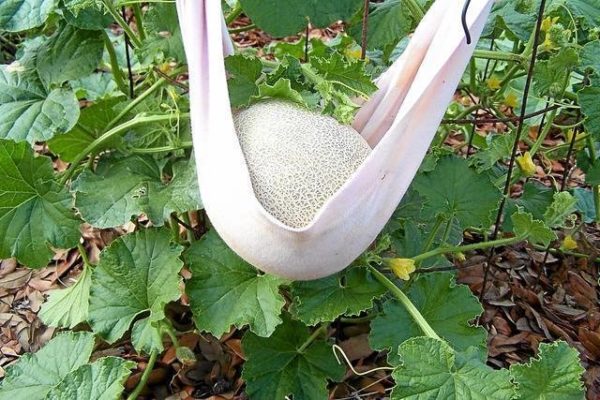
Pollination
When growing fruit in greenhouse conditions, it is necessary to carry out artificial pollination.
As soon as the flowers of the female type bloom, they like the rules bloom in the morning, it is necessary to start pollination immediately. To do this, male flower bare to stamens and touch the pistil of the female flower. After this, it is important to check for the presence of pollen on the pistil. If doubts have arisen in pollination, it is necessary to repeat the procedure, but with another male flower.
If you do not carry out manual pollination, the formation of the fetus will not occur.
In hot weather, it is necessary to periodically air the greenhouse. To attract pollinating insects, female flowers are sprayed with sugar syrup, a container with honey solution is set.
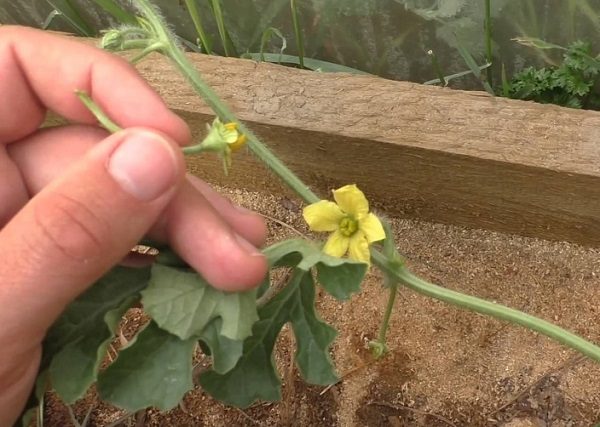
Watering bushes
Watering the plant is necessary only with warm water (30-33 degrees), when watering with cold water, the root system may rot and the plant will die.
With the formation of fruits, watering increases.
Watering should be moderate.The root system of the culture is pivotal and goes deep into the soil, so the melon receives additional moisture from the bowels of the earth. Because of the overflow, the plant begins to hurt, the fruits rot and crack.
Water shortage is checked by foliage. If the leaves nick, then the plant needs additional watering.
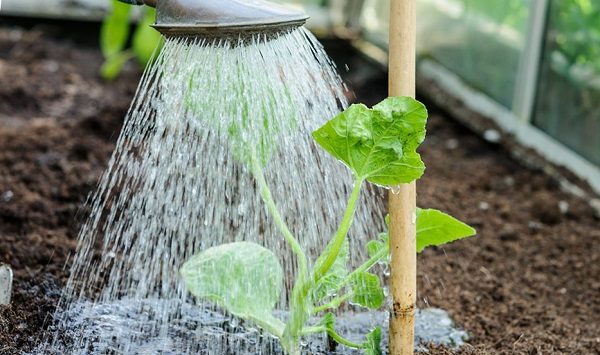
The possibility of joint planting seedlings with other plants
Melons can be planted with other cultures, such as:
- Pepper
- Cucumbers
- Eggplant
Experienced gardeners grow berries in individual greenhouses, as the culture requires a certain temperature (about 30 degrees) and a small air humidity. If the neighborhood is inevitable, planting seedlings is desirable according to a certain pattern.
With a short light day set artificial lighting.
The plant can tolerate a slight drought, but at high humidity can get fungal diseases.
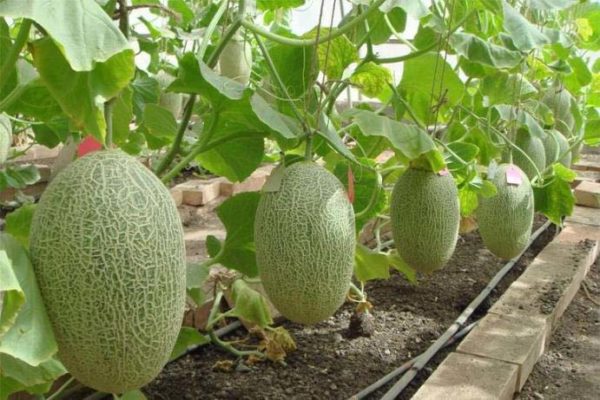
Harvesting
Melon reaches technical maturity, with proper care, in early August. You can determine ripeness by appearance. The tail of a ripe melon forms ring cracks, and the fruit itself exudes an unforgettable scent.
The fruit must be slightly squeezed in his hands and if he springs inside, then he is ready for use.Fruits are transported in boxes, with each wrap wrapped in wax paper, so that they do not touch each other and do not rot.
If you set a goal to grow a melon in a greenhouse, then you need to properly care for it, shape the fruit. A fetus without damage, torn off in its immature condition, will ripen quickly in a dry and warm room, without losing all its healthy qualities and unique taste.
